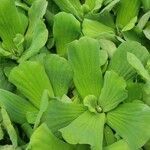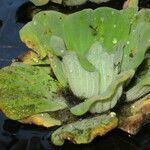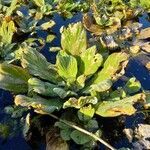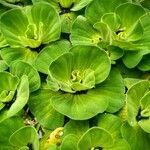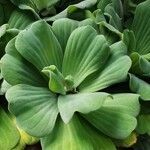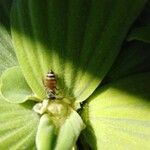Floating mat-forming stoloniferous aquatic; stem condensed; leaves shortly petiolate, suboblong, hairy, inflated, in a lettuce-like rosette to c. 30 cm diam. (usually less). Inflorescence mostly solitary, physiognomically axillary, inconspicuous at leaf bases, c. 1 cm long; spathe hairy outside, slightly constricted; limb subcampanulate, white inside; spadix shorter than spathe; female zone a solitary naked pistil adnate to spathe; male zone a stipitate ring of anthers subtended by a membranous collar; appendix absent. Fruit a multi-seeded inconspicuous greenish berry.
A floating herb. This plant looks something like a lettuce and grows on water. The water needs to be stagnant or slow moving. The leaves are produced in a rosette. They are light green. The leaves are hairy and have 7-15 ridges. The plant sends out runners. These end with a tuft of leaves. The leaves overlap and are without stalks. They arise from the same level. Plants are of separate sexes. The female flowers occur singly and are at the base. Male flowers have a single stamen and occur as 2-8 flowers together. They are at the end of the plant.
Plants emitting numerous long, slender roots; primary leaves rounded or broadly obovate, the adult ones numerous, spreading to form a dense rosette, obovate-cuneate or obovate-oblong, broadly rounded or emarginate at the apex, cuneately narrowed to the rather broad, sometimes sub-petiolate base, mostly 5-10 cm. long and 2-5 cm. wide, with 5-15 parallel nerves, these prominent beneath, the blades green or grayish green on the upper surface, pale beneath.
Plant reproducing vegetatively by stolons.. Leaf-blade up to 14 cm. long, 8 cm. broad, spathulate, obconic or oblong, apex rounded to truncate, green, paler and more densely pubescent beneath; main veins 5–7, prominently winged beneath.. Spathe to 1.3 cm. long, whitish green, margins and exterior fimbriate-pilose.. Berry to 0.5 cm. long, 0.3 cm. broad.. Seeds to 0.2 cm. long, 0.1 cm. in diameter, reddish brown.. Fig. 17.
Aquatic, free-floating, small, lettuce-like herb, 100-200 mm in diam., with hanging feathery roots. Leaves in a rosette, up to 150 mm long, soft, thick-ridged, covered densely in short hairs, keeping plants afloat. Inflorescence a spadix wrapped in a white spathe, solitary, at centre of plant, hidden among leaves, with a single female flower below, 2-8 male flowers above. Flowering time Dec.-June.
Aquatic herb. A floating, stoloniferous, stemless herb with a tuft of fibrous roots. Leaves sessile in a rosette, cuneate-obovate, with flabellate veins, raised below. Spathes axillary with very short peduncles, green.
Morphological characters are the same as those of the genus. Plants aquatic, floating. Roots many, pendulous in water, feathery. Leaves in rosettes, 1.3-10 × 1.5-6 cm. Spathe white, 5-12 mm. Fl. May-Nov.
A floating herb, propagates mainly by stolons and forming immense colonies
Flowers obscure beneath the rosette of glandular viscid leaves.
Roots numerous, fibrous, reaching the bottom in shallow water
